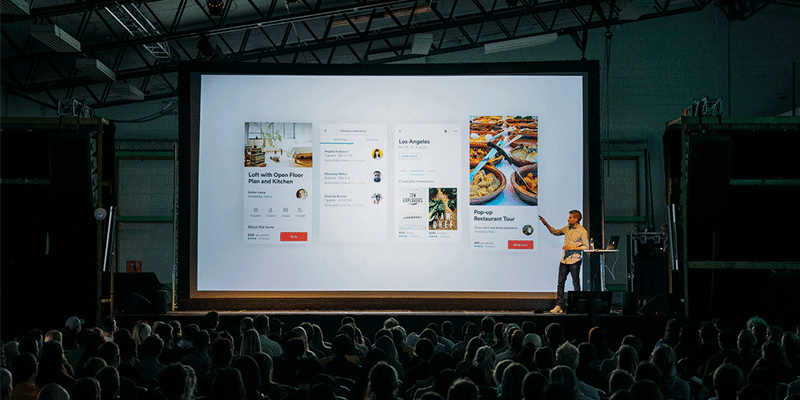Back in the 20th century, if you wanted to attend a seminar happening in Silicon Valley, California, where Elon Musk or Sundar Pichai is the speaker you would have to go to that location. But, thankfully it’s the 21st century, and anyone can attend a seminar staying from anywhere. In this blog, we will discuss what is a webinar, how it works and what are its advantages and what are the elements of a good webinar.
What is a webinar?
The word webinar is the mix of two words – web and seminar and is an event conducted on the internet exclusively attended by online audiences. It is a presentation, lecture, seminar, workshop transmitted over the web using video conferencing software.

To define webinar in simple words, a webinar is a real-time online meeting held via the internet. It connects the individuals who are the viewers from different parts of the world. Interactivity or the ability to discuss, send and receive information in real-time; these are the main features of a live webinar.
How does a webinar work?
Technically, a webinar solution or software is invoked by all participants in a webinar. Some webinar solutions include software and functionality that differ for the host and the audience. A webinar solution may run as a web browser application and some webinar solutions require to download and installation of the software on each participant’s computer. A webcam is used to display the visual of the participants and the participants see the visuals of the host on the computer screen. Participants speak and listen to audio via computer microphones and speakers.
10 Best remote desktop & screen sharing software | Free & paid software
Webinar solutions are usually licensed as a service based on pricing models. Some webinar solutions are free of cost. While the chargeable ones vary – fixed cost per minute per user and monthly or annual fee, allowing unlimited use with maximum capacity per session. A webinar, along with the visuals of the speaker, is also accompanied by images, videos, documents, presentations, etc. The presentation of visual materials is accomplished through directly visualising the image of the presenter’s computer screen to the participants instead of the speaker’s visuals. The speaker would select the appropriate image, video, presentation through their computer screen.
How to do a webinar?
Apart from the technical know-how, it is important to understand how a webinar works in actual.
Before a webinar takes place, the host must fix an appointment and invite the desired participants. Generally, there is a limit to the number of participants. So those who are interested must register to attend the session. The host would, later on, send a confirmation email to the selected participants. The email contains instructions along with the details of the login and access link. Participants connect to the webinar which requires standard internet connectivity. Connecting to a webinar is possible only for a limited period. If you start the login procedure after the expiration of the deadline, the access is stopped after a few minutes, an online seminar has begun.

Best virtual classroom software in 2020 | Set up your Virtual classroom
What device do you need to conduct or participate in a webinar session?
To conduct or participate in a webinar, you require the following devices and installations.
- Personal computer, laptop, smartphone and tablet. Almost all the webinar solutions are functional in all the above-mentioned devices.
- Few webinar solutions are required to be installed in the system while some can be accessed via an internet browser.
- A webcam is required for personal computers to enable visual conferencing
- Microphones and speakers are required to listen and talk to each other.
What are the types of webinar?
Based on the release and availability of content, webinars can be classified into three categories.
1. Live webinars
A live webinar is when you are presenting the online seminar in real-time to a live audience. These sessions are usually one-time events that occur during a specified date and time. There are no options to pause such engaging webinars. It happens as it is like a person demonstrating in real-time.
2. On-demand webinars
On-demand webinars are also known as pre-recorded webinars. A webinar or a training session is recorded in prior and you invite people to watch the pre-recorded webinar on a certain platform. It is signed up by the audience to watch it later on at the time of their convenience.

12 Highest paying remote jobs in 2020 | Best Work from home jobs
3. Automated webinars
Automated webinars are almost the fashioned version of on-demand webinars. The only difference is that the time to release the pre-recorded webinar is pre-fixed by the presenter. In simple words, the presenter records and upload the webinar to a certain platform, the date and time of release are set. When the said date and time arrive, the webinar is streamed live to the audience.
What are the features of a good webinar?
Online seminars are interesting and make the participants enthusiastic for the organisers and the participants. The live session which helps people located in distinct locations to take part in the seminar are the key feature of a webinar. There are many free and paid webinar software and services to choose from, some of the common features of the webinar solutions include the following.
1. Live sessions
This is the key element and one of the main uses of webinar. This feature helps the persons located in distinct places to attend live webinar sessions. It is an online presentation held via the internet in real-time. The ability to interact and discuss is the main element here. In some webinar solutions, the attendees are only able to chat with the host. The provisions are limited in number for the attendees to interact with the host.
2. Sharing relevant documents and presentation
During a webinar, the host can share relevant presentations, documents, videos, images, etc. In many seminars/webinars, the session begins with videoed introductions. Often, presentations are the beginning and the reference point of the webinars. This feature is a hand-in-hand tool for the host.
10 Best Online Whiteboards For Better Remote Meetings
3. Whiteboard
Like, how a white/blackboard is important for a seminar, a whiteboard is also important for conducting a webinar. The host would need a whiteboard to make such sessions interesting. Whiteboards are commonly used to make it an engaging webinar for the audience. Text boxes, drawing tools, shapes and erasers are used to illustrate the ideas and enrich the webinar content.
4. Desktop sharing
Desktop sharing is a simple solution available in most of the webinar solutions. As the name suggests, desktop sharing enables the remote participants to view your desktop. Desktop sharing is also known as screen sharing. In simple words, it is the practice of sharing the contents of your screen with another or multiple devices.
5. Chat
This feature allows the attendees of the webinar, hosts and the panellists to communicate for the duration of the webinar. Most webinar solutions have a chat function that allows every participant to type brief messages to each other. In many webinar solutions, if attendees can chat with other attendees, panellists, host, or only the host depends on the settings that the host has selected.
6. Recording
This feature of a webinar can also be considered as an advantage and main uses of webinars. A seminar cannot be recorded until it is installed with necessary set-ups. But, the webinar software has the ability to record the live video and save it in the cloud storage. Anyone who missed the chance to attend a webinar can watch the recorded video later.
Best note taking apps in 2020 | Note taking made easier
7. Polls and surveys
Polls and surveys help in gathering insights, opinions and feedback from the attendees. Running polls and surveys on any topic during the webinar helps to gather opinions and feedback from the audience about the session. These results should be analysed to improve future seminars and make informed business decisions.
Tip: Polls and surveys, chat options help you to understand the questions and opinions of the audience. A better understanding of all the features helps you to present a healthy session.
What are the pros and cons of a webinar?
The contents could theoretically be similar, but online seminar differs from the conventional face-to-face seminar. Webinars offer some advantages to classical lectures, but at the same time, they also come with some disadvantages. The online seminar format scores especially when it comes to being location independent. Further, it saves money & time for both speakers and the participants. On the other hand, you are totally dependent on technology where technical glitches are inevitable. If the device of the participants is broken or if there is any problem with internet connectivity, they can’t take part in it. The webinar might have to be cancelled or postponed if there is any technical problem from the speaker’s side.
Virtual Icebreakers | How to have a smooth first remote meeting?
Advantages of hosting a webinar
1. An opportunity for everyone: A webinar is an open platform that offers opportunities to everyone not bothering about the individual’s current location. Unlike seminars, where it could be attended only by those who are present in a certain location, a webinar eliminates the barrier of physical presence in a certain location.
2. Saves cost: Webinars help in reducing the cost incurred for travel. To attend the conventional seminars, one has to spend some currency for travelling. A webinar can be seen as a cost-effective method of conducting the same.
3. Limit to the number of participants: In the traditional one, you can’t be able to accommodate more than a certain number of individuals. Practically, there is no limit to the number of participants to attend a webinar. In theory, the maximum number of participants depends on technical conditions.
4. Record a session: This is one of the main advantages of webinar sessions. The webinar sessions are recorded easily. Unlike the traditional one, a webinar doesn’t need any additional installations. Those who were not able to attend the live sessions could see the recorded video of the entire session.
5. Share documents: References are important for any seminar/webinar. Webinar helps to display the relevant documents, images, videos, etc. Prior projector installation is required for the conventional one – seminar. In a webinar, no such installations are required as it is a come along of webinar solutions.

Meeting Minutes: What is it & how to write it effectively (step by step)
Problems to be aware of before hosting a webinar
1. Technical problems: There is a risk of technical difficulties during the presenter’s time in the podium. Technical issues can lead to the cancellation of the event or prevent participants from participating in it.
2. Difficult to determine the mood: For a speaker, it would be difficult to determine the mood of the participants. If it is a seminar, the speaker would be able to observe the mood of the audience and could alter the speech’s tone later on. Also, body language is missing in virtually engaged seminars. Lack of clapping, handshakes and standing ovation leads to apathy.
3. Distractions: As there is no one to look over the participants, they could be easily distracted due to their surroundings and other circumstances. Also, the presenter has no control over the environment and they cannot ensure that there will be no interruptions and distractions. This sort of happenings would lead to a lack of focus.
4. Almost zero interaction: The interaction between the audience and the host is too less compared to the seminar sessions. This is the main downsides of webinars, the lack of interaction between participators and presenters. As everything is conducted online, there is only visual audio interaction lacking direct physical interaction.
5. Teamwork: Webinars are also conducted for team training. For team training, teamwork is an essential part as it adds value to the task everybody is involved in. Webinars completely eliminate this aspect as everything is virtual.
Managing Remote Teams: 13 tips that will come handy
FAQs
1. What is a webinar?
To define webinar in simple words, it is a real-time online meeting held via the internet. It connects the individuals who are the viewers from different parts of the world.
2. What devices do I need for a webinar?
A personal computer is the most basic requirement. Microphones and speakers are required to listen and interact. A webcam is required for visual conferencing. The last requirement is the installation of webinar solutions or an internet browser to access the webinar. Generally, all the webinar solutions are supportive of a tablet or a smartphone which would suffice all the requirements of the above-mentioned devices except the installation of a webinar solution.
3. How does a webinar work?
A webinar is an engaging online event where the speaker addresses a large audience who participates by responding to polls, submitting questions and using other interactive tools. They initially register for a particular session. After the selection, the participants receive a mail containing the login details and links to access.
4. Are webinars recorded or live?
Webinars can be broadly classified into two categories. They are live and recorded. Live webinars and obviously live.
5. Can others see you during a webinar?
The audience does have the ability to see the presenter. The audience, in most webinar solutions, can only type in and submit the questions to the speaker during the live session. The presenter, in most cases, would not be able to see or hear the audience.
6. What is the difference between a podcast and a webinar?
A webinar is an online seminar held in real-time for people all around the world and they are commonly multimedia – contain both audio and video. A podcast normally includes only audio.
7. What is the best webinar software?
GoToWebinar, EasyWebinar, Adobe Connect, Google Hangouts, and Zoom are the best webinar software.
8. How to do a webinar?
The host must fix an appointment and invite the desired participants. Generally, there is a limit to the number of participants. So those who are interested must register to attend the session. The host would, later on, send a confirmation email to the selected participants along with the details of login and access link.




Leave a Reply